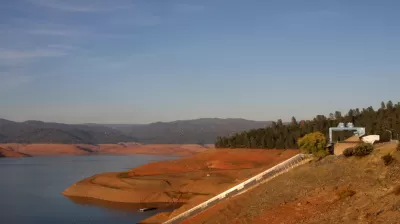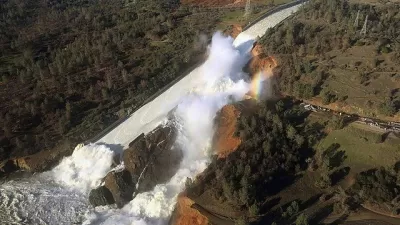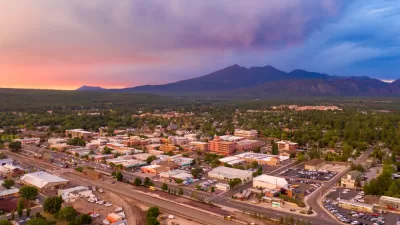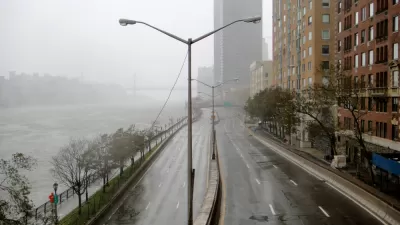Swings in weather-related fortunes will continue to push to unprecedented extremes, in California, in Texas, in Boston, in Long Island, in Louisiana, and everywhere else.

Is anyone feeling resilient enough to talk about resilience?
To add to the overwhelming evidence that 2017 has not been a good year for the resilience cause, those of us who live and work in California got a stark reminder of vulnerability this week, when crisis came in the form of stormwater at Lake Oroville in Northern California.
A year ago, residents of California were surrounded on all sides by historic drought and crossing their fingers for an El Niño to remember. The average rain year (at best) we were left with would be better described as El No Show. This year, with predictions of La Niña's dry weather all but assuring another year of drought, the entire state has instead been doused with rain without stop since November. A break arrived just in time this week to temporarily stave off the threat of property damage and potentially much worse below Lake Oroville.
Even on this week's sunny days, the spillways below Lake Oroville have crumbled away, bit by bit and sometimes in large chunks, in plain sight of the news helicopters hovering above. The risk of a larger failure was obvious enough to necessitate mandatory evacuation orders, blasted to the Oroville region on Sunday evening. A map of communities threatened by the potential rupturing of the emergency spillway at Lake Oroville shows the threat extending south along the Feather River watershed, through communities like Gridley and Yuba City. I'm just naming the places where friends of mine live and work. There are many more. The San Jose Mercury News reported on February 14 that 200,000 residents have evacuated the area. A few hours later on the same day, the mandatory evacuation order was dialed back a notch to an evacuation warning and residents began to return home.
There are some critical points to make while there's a moment for reflection between storms. It will be necessary for the survival of huge swaths of humanity to understand and accept a simple reality: Resilience must address the challenges of both scarcity and abundance. There is no resilience without a plan, and the infrastructure, for both.
Resilience has always meant the capacity to persist through droughts and deluges, though states like California have tended to ignore one end of the spectrum for the other, while satisfying the demands of neither. In the relatively near future, however, resilience will require the capacity to persist through droughts and deluges of more extreme duration and intensity than anything we've encountered so far. That's not a claim made by alarmists, but by scientists like those at the Intergovernmental Panel on Climate Change (IPCC) , the World Meteorological Organization (WMO), and the California Environmental Health Tracking Program. Resilience in the future will require infrastructure with far greater capacity than anything the country has now.
Anne C. Mulkern published an article on Scientific American this week predicting that the emergency at the Oroville Dam this week will foreshadow events to come as the effects of climate change take their toll. The Los Angeles Times editorial board expanded the concept of the crisis another way, noting that a disaster at Oroville Dam would also be a disaster for the city of Los Angeles, located some 460 miles to the south.
Less clear than the lessons about the scale of the country's infrastructure challenges in the face of climate change are lessons about how to discuss these partisan issues of water, resilience, and climate change. Since the evacuation order went out to the city of Oroville on Sunday night, people all over the country took to social media to point fingers of blame (look at the response thread on this tweet by The Washington Post as an example) and others to celebrate the potential demise of a state led by the Democratic Party and a record of voting for the Democratic Party at the national level (look at the level of discussion underway at #Oroville or #OrovilleSpillway as an example).
The news that a coalition of environmental groups tried to warn the state and federal governments about the same vulnerabilities in the Oroville Dam's spillway that have resulted in this week's emergency should provide direction on future decisions. Clearly the state and federal governments will have to re-evaluate the policies and ideas that enabled the 2005 decision not to upgrade the Oroville Dam's spillways, as an editorial by the San Jose Mercury News editorial board suggests. We can't settle for proving the culpability of bureaucrats or allowing an avalanche of partisan schadenfreude as the only results to come from this emergency.
Right now, with emergency crews working hard to patch the holes in the Oroville Dam's emergency spillway and the threat far from past, the opportunity to teach and learn about the vulnerabilities of the country's safety and health will never be more obvious.
The ongoing spectacle of water careening down the dam's main spillway is a good place to start toward a higher level of the conversation about resilient water infrastructure. Despite developing a large crack on February 6, Oroville Dam's main spillway has released 100,000 cubic feet per second (cfs) of water for much of the emergency, pausing briefly on February 7 for an inspection and dropping to lower flows at other times over the course of the last week.
For sake of comparison, the average discharge of the Los Angeles River at its mouth in Long Beach is 226 cfs, according to Wikipedia. The record flow of the Colorado River through the Grand Canyon on February 14, in 93 years of historic data, is 26,800 cfs. Here's a reminder of what the Colorado River looks like in the Grand Canyon at the more innocuous flow of 9,000 cfs.
Multiply the flow by ten and it's easy to imagine that much water knocking around the state's collective confidence like the rafts navigating Lava Falls in the Grand Canyon. Just a few months ago that 100,000 cfs might have seemed like enough water to last 13 people an entire year. Well:
100k cfs = about what 50,000 people in California use in a year every hour. What 13 people use in a year every second.
— Credible Source (@VamonosLA) February 13, 2017
In addition to the tweets above, Let's Go LA has also produced a detailed explainer of the State Water Project, of which Lake Oroville is a critical component, to help explain the situation in context of its potential impact on the rest of the state. The Feather River below Lake Oroville will eventually flow into the California Aqueduct and beyond to farmland and population centers farther south, so this isn't all lost water. However, the massive amounts of water moving down the Oroville Dam's spillway provides powerful illustration of the stakes of the emergency.
It should be very difficult to watch that water explode into the air off the rocks below the dam's broken primary spillway and not think of the still very recent drought crisis. It's hard to fathom how we moved so quickly from a historic drought to a historic onslaught by the fury of mother nature. Oroville Lake is designed to be kept 20 percent below capacity during the spring and winter months, to allow for the impounding of flood water. This winter's storms are all it took to overwhelm the reservoir's capacity, and then some. The dam is also designed to release less than 150,000 cfs to prevent flooding downstream of the Feather River's confluence with the Yuba River, where flows can reach 300,000 cfs, according to a flood assessment by the U.S. Army Corps of Engineers [pdf]. The Oroville Dam and its supporting structures are central, critical components of flood control and water supply infrastructure for the entire state (not to mention local electricity supply). Any failure to balance those sometimes conflicting needs would have catastrophic consequences, as we witnessed this week.
White House Press Secretary Sean Spicer recently suggested that the Trump Administration's infrastructure proposal would solve emergencies such as the situation at Oroville Dam. Environmentalists have pointed to the floodplain restoration of another watershed in California, the San Joaquin River, as a model of success achieved by a more holistic approach to infrastructure. There are many more resources available to better inform the public about the complex political, environmental, and economic systems that contributed to the Oroville Dam emergency. The need for solutions goes beyond politics—preventing emergencies like Oroville's will only be possible if stakeholders look beyond their ideological allegiances and commit to viable, maintainable solutions.
We can't afford to be wrong, or irresolute, this time. Resilience will be necessary, one way or the other.

Maui's Vacation Rental Debate Turns Ugly
Verbal attacks, misinformation campaigns and fistfights plague a high-stakes debate to convert thousands of vacation rentals into long-term housing.

Planetizen Federal Action Tracker
A weekly monitor of how Trump’s orders and actions are impacting planners and planning in America.

In Urban Planning, AI Prompting Could be the New Design Thinking
Creativity has long been key to great urban design. What if we see AI as our new creative partner?

King County Supportive Housing Program Offers Hope for Unhoused Residents
The county is taking a ‘Housing First’ approach that prioritizes getting people into housing, then offering wraparound supportive services.

Researchers Use AI to Get Clearer Picture of US Housing
Analysts are using artificial intelligence to supercharge their research by allowing them to comb through data faster. Though these AI tools can be error prone, they save time and housing researchers are optimistic about the future.

Making Shared Micromobility More Inclusive
Cities and shared mobility system operators can do more to include people with disabilities in planning and operations, per a new report.
Urban Design for Planners 1: Software Tools
This six-course series explores essential urban design concepts using open source software and equips planners with the tools they need to participate fully in the urban design process.
Planning for Universal Design
Learn the tools for implementing Universal Design in planning regulations.
planning NEXT
Appalachian Highlands Housing Partners
Mpact (founded as Rail~Volution)
City of Camden Redevelopment Agency
City of Astoria
City of Portland
City of Laramie






























